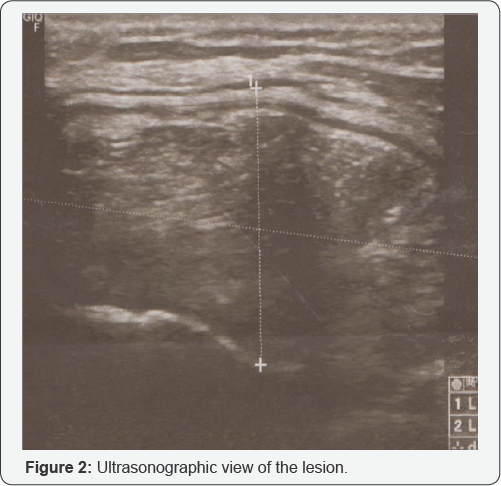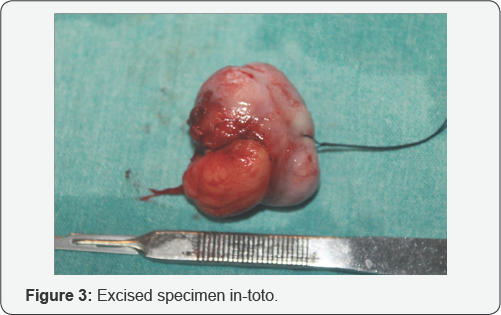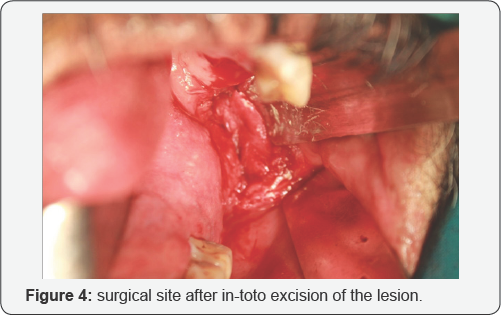A Rare Case of Large Intra Oral Lipoma-Diagnosis and Management
KP Manojkumar1, Shermil Sayd1*, Shijo Dany Kurian1 and BR Ashna2
1Department of Oral and Maxillofacial Surgery, Kunhitharuvai memorial charitable trust (KMCT) Dental College and Hospitals, India
2Department of Oral Medicine and radiology, Kunhitharuvai memorial charitable trust (KMCT) Dental College and Hospitals, India
Submission: January 26, 2017; Published: December 08, 2017
*Corresponding author: Shermil Sayd, Kunhitharuvai memorial charitable trust (KMCT) Dental College and Hospitals, Department of Oral and Maxillofacial Surgery, Manassery, Calicut-673601, India, Tel: +919446230425; Fax: +91495 2294726; Email: shermil12@gmail.com
How to cite this article: KP Manojkumar, Shermil S, Shijo D K, BR Ashna. A Rare Case of Large Intra Oral Lipoma-Diagnosis and Management. Adv Dent & Oral Health: 2017; 6(5): 555696. DOI: 10.19080/ADOH.2017.06.555696
Abstract
Lipomas are said to be the most common soft tissue benign mesenchymal neoplasm of fat cells with an incidence of 15-20%. They have a higher incidence of occurrence in the posterior neck region. There occurrence in the oral cavity is rare, amounting to 0.5-5% of all the benign tumors. The most frequent sites of presentation are lips, tongue, palate, buccal mucosa, gingivo-buccal sulcus and the floor of the mouth. A review of the available English literature has shown that a maximum size of 5cm has been reported for intraoral lipomas. In this case report, we are reporting a case of longstanding, large, intraoral lipoma of size >6cm in a medically compromised patient and its management by surgical excision. Histological examination following lipoma excision is imperative to detect or exclude liposarcomatous degeneration. Complete removal of the lesion should be done so as to avoid recurrence.
Keywords: Lipoma; Intraoral lipoma; Rare benign intraoral neoplasm
Opinion
Lipomas are said to be the most common soft tissue benign mesenchymal neoplasm of fat cells with an incidence of 15-20%. The first description of oral lipomas was provided by Roux in 1848 in a review of alveolar masses. He referred to it as a "yellow epulis” [1] . They have a higher incidence of occurrence in the posterior neck region. There occurrence in the oral cavity is rare, amounting to 0.5-5% of all the benign tumors [2]. Clinical presentation of intraoral lipoma is usually a well-circumscribed, painless, slowly enlarging submucosal mass and may be superficially or deeply seated [3,4].
Superficial lipomas can be differentiated by the presence of yellowish tinge on its mucosal surface. The etiology and pathogenesis of lipomas are still in debate, with various authors suggesting mechanical, endocrine, and inflammatory causes [4]. Clinical diagnosis for lipomas is usually apparent, and the use of imaging studies aid in diagnosis. The base of the lesion can vary as being pedunculated or sessile [4]. The most frequent sites of presentation are lips, tongue, palate, buccal mucosa, gingivo- buccal sulcus and the floor of the mouth [5,6]. A review of the English literature has shown that a maximum size of 5 cm has been reported for intraoral lipomas.
Here, we are reporting a case of longstanding, large, intraoral lipoma of size ≥6cm in a medically compromised patient and its management.
CaseReport
A 52-year old male patient reported to Department of Oral and Maxillofacial Surgery, KMCT Dental College and Hospitals, complaining of a slow growing mass inside the left side of mouth since 2 years. It started as a single soft swelling of size 0.5cm which originated on the left buccal mucosa near to the retromolar region. It attained a size of 1.5cm in the first few months, and then remained static for a long period. Six months prior to the excision, the swelling size again started increasing to the present size. Occasional traumatization of the lesion occurred while chewing. There was no history of any co-morbidities or regular medications. Personal history revealed that he is an alcoholic and cigarette smoker.
On intraoral examination, there was a large ovoid pedunculated swelling of size 6cm x 4cm x 3cm on the left buccal mucosa, originating near the retromolar region (Figure 1). Surface bosselation with areas of fibrosis was present, which may be attributed to the self-inflicted trauma during mastication. On palpation, it was soft in consistency and showed compressibility. Keeping the social status of the patient in consideration, we decided to go for a high resolution ultrasonographic examination, and magnetic resonance imaging, if indicated. Color Doppler ultrasonographic examination revealed that the lesion was well defined, heterogeneously hyperechoic with no obvious vascularity and no signs of intramuscular infiltrations, eliminating the need for expensive magnetic resonance imaging (Figure 2). Fine needle aspiration cytology was done and on histopathological examination it showed more number of fat cells than the normal mucosa. With a hypothetical diagnosis of lipoma patient was suggested surgery under general anesthesia.


The patient underwent pre-operative routine examinations, which showed an increased blood glucose level and blood pressure, and was advised with multispecialty consultations, which diagnosed him with type 2 diabetes mellitus and hypertension. Necessary medications were given, and once his co-morbidities were under control, we proceeded with the surgery.
Under hypotensive general anesthesia, surgical site was infiltrated with vasoconstrictor. A suture was passed through the lesion for orientation and to aid in retraction. A number 15 scalpel blade was used to place an incision around the pedunculated base of the lesion, followed by blunt dissection. The whole lesion was excised in-toto (Figure 3). The base of the lesion was made clear of all tissues until the muscle layer was left (Figure 4). After attaining hemostasis, closure was attained using resorbable sutures. Postoperative period was uneventful and the patient was discharged on the third day. Histopathological examination of the gross specimen confirmed the lesion as intraoral lipoma (Figure 5). Post-operative reviews showed good healing of the surgical site.



Discussion
Lipomas are benign soft tissue neoplasms of mature adipose tissues. Etiology of lipomas has been elusive with various authors suggesting various factors, the "hypertrophy theory” being the favorite of them all. This theory states that obesity and inadvertent growth of adipose tissue may contribute to formation of oral lipomas. The disadvantage of this theory is that it fails in addressing lipomas which develop in areas where adipose tissue is absent [7]. Another theory, the "metaplasia theory”, suggests that a lipoma develops due to aberrant differentiation of in-situ mesenchymal cells to lipoblast. This theory is based on the fact that the fatty tissue can be derived from mutable connective tissue cells almost anywhere in the body [8]. Lipomas have been reported in all parts of the body. But the occurrence of intraoral counterpart is very rare. Intraoral location of occurrences: oral mucosa (increased occurrence) tongue, lips, floor of the mouth, palate and gingival, follows the pattern of decreasing amount of fat deposition [9,10]. Occurrence of intraosseous lipomas has also been reported by Oringer [11] and Johnson [12].
Freitas et al. [5] published a review article which reported the mean age of occurrence for lipoma is 54.6 years. Dimitrakopoulos et al. [13]. reported rare cases of congenital lipomas in a 20-day and 47-day old babies. Fornage et al. [14] reported that the peak incidence of lipomas occur between fifth and sixth decades. There are occurrences of lipoma with female predominance [4] and with no sex predilection [14] reported. There are many authors who also suggest that the peak incidence of lipoma occurs above 40 years of age.
Clinically, intraoral lipoma presents as a painless, smooth surfaced, slowly enlarging submucosal mass which may be superficially or deeply seated. But the characteristic may change depending upon the location of occurrence. Diagnosis of lipoma is usually difficult when the lesion is deeply seated, in which case we need to recruit the help of other investigative modalities. Lesion may be pedunculated or sessile and occasionally with surface bosselation. Literature review shows that the size of the lesion varies from 0.2-1.5cm in diameter. But there are reported cases of lipomas up to sizes of 5cm [15]. But in this case, the size of the lesion has reached a size of 6cm, with duration of three years during which period the size kept on increasing. The duration of lipoma occurrence from 2 to 84 months, with a mean of 30.4 months [16]. Presence of intraoral lipomas may lead to functional interferences like difficulty in mastication, speech problems and dysphagia.
There have been reports of occurrence of multiple lipomas, usually associated with certain syndromes like Gardner's syndrome, Decrum's disease, encephalocraniocutaneous lipomatosis, Proteus syndrome, multiple familial lipomatosis and Paisyndrome [17]. Differential diagnosis for intraoral lipomas includes benign salivary gland tumour, ranula, benign mesenchymal neoplasm, ectopic thyroid tissue, lymphoma, and oral dermoid and epidermoid cysts [18]. Even though computed tomography and magnetic resonance imaging are the preferred investigative modality, histopathological confirmation still remains the gold standard in the diagnosis of lipomas. High resolution ultrasonographic studies can also be used for this purpose, as done in this case. They also yield accurate results, which is comparable to other investigative modalities. In all the situations, the final diagnosis will be based upon the histopathological report.
Based on the histological features, lipomas are classified into classic lipoma, fibro lipoma, angiolipoma, spindle cell lipoma, and pleomorphic, myxoid, sialolipoma, and intramuscular lipomas. But in general, lipomas appear to be composed of adult fat cells, which are again subdivided into lobules by fibrous connective tissue septa [2] . Most frequent histological subtype in the oral cavity is simple lipoma, followed by fibro-lipoma. Lipomas usually demonstrate chromosomal aberrations such as translocations between 12q13-15, interstitial deletions of 13q and rearrangements of 8q11-13 locus [4].Complete surgical excision, irrespective of the histological variant, is the mainstay treatment. Less incidence of recurrences have been reported, except for the infiltrating variety of lipoma. Infiltrating or intramuscular lipoma originates between skeletal muscle bundles and infiltrates through the intramuscular septa. Due to the close relationship between the adipose tissue and the muscular layer, they show predilection for tongue.
Medical management of lipomas is also gaining popularity. This technique includes intralesional injection of steroids, leading to local fat atrophy, thus, shrinking the tumour size. It is only recommended for lipomas with diameter less than 1 inch. Repeated injection of 1:1 mixture of lidocaine and triamcinolone acetonide, once a month, into the central region of tumour is also recommended [18].
Conclusion
Oral lipomas are rare benign mesenchymal tumors. They are asymptomatic till they get larger in dimensions. Histological examination following lipoma excision is imperative to detect or exclude liposarcomatous degeneration. It is always not necessary to go for higher imaging modalities like MRI for the diagnosis of lipomas. Unless indicated, high resolution USG can act as an alternative cost-effective method for diagnostic imaging in cases of lipoma. This article goes on to show that the even though the lesion is large, the management of a lipoma by complete removal of the lesion to avoid any recurrence, remains same, irrespective of the size.
References
- Roux M (1848) On exostoses: there character. Am J Dent Sci 9: 133-134.
- Fregnani ER, Pires FR, Falzoni R, Lopes MA, Vargas PA (2003) Lipomas of the oral cavity: Clinical findings, histological classification and proliferative activity of 46 cases. Int J Oral Maxillofac Surg 32(1): 49-53.
- de Visscher JG (1982) Lipomas and fibrolipomas of the oral cavity. J Maxillofac Surg 10: 177-181.
- Sachdeva S, Rout P, Dutta S, Verma P (2013) Oral lipoma: An uncommon clinical entity. J Oral Maxillofac Radiol 1(3): 118-121.
- de Freitas MA, Freitas VS, De Lima A, Pereira FB, dos Santos JN (2009) Intraoral lipomas: a study of 26 cases in a Brazilian population. Quintessence Int 40(1): 79-85.
- Aust MC, Spies M, Kall S, Gohritz A, Boorboor P, et al. (2007) Lipomas after blunt soft tissue trauma: are they real? Analysis of 31 cases. Br J Dermatol 157(1): 92-99.
- Gupta TK Das (1970) Tumors and tumor-like conditions of the adipose tissue. Curr Probl Surg 7(3): 3-60.
- Ashley D (1978) Evans Histological Appearances of Turnouts (3rd edn), Livingstone, Edinburgh, Scotland, UK.
- Lucas RB (1984) Pathology of Tumours of the Oral Tissues.
- Studart-Soares EC, Costa F, Sousa FB, Alves A, Osterne R (2010) Oral lipomas in a Brazilian population: a 10-year study and analysis of 450 cases reported in the literature. Med Oral Patol Oral Cir Bucal 15(5): e691-e696.
- Oringer MJ (1948) Lipoma of the mandible. Oral Surgery Oral Med Oral Pathol 1(12): 1134.
- Johnson E (1969) Intraosseous lipoma: report of case. J oral surgery 27(11): 868.
- Dimitrakopoulos I, Zouloumis L, Trigonidis G (1990) Congenital lipoma of the tongue. Report of a case. Int J Oral Maxillofac Surg 19(4): 208.
- Fornage BD, Tassin GB (1991) Sonographic appearances of superficial soft tissue lipomas. J Clin ultrasound 19(4): 215-220.
- Epivatianos A, Markopoulos AK, Papanayotou P (2000) Benign tumors of adipose tissue of the oral cavity: a clinicopathologic study of 13 cases. J oral Maxillofac Surg 58(10): 1113-1117.
- Tettamanti L, Azzi L, Croveri F, et al. (2014) Oral lipoma: Many features of a rare oral benign neoplasm. Head Neck Oncol 6(3): 21.
- Larsen K, Juul A, Kristensen S (1984) Intraoral lipoma A rare cause of dysphagia. J Laryngol Otol 98(10): 1041-1042.
- Kumar L, Kurien NM, Raghavan VB, Menon PV, Khalam SA (2014) Intraoral lipoma: a case report. Case Rep Med 480130-480130.






























